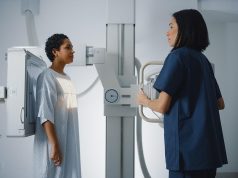Validated machine-based learning model performs better than surgeons, radiologists, CADx for predicting malignancy
THURSDAY, Feb. 25, 2021 (HealthDay News) — A machine learning-based model has been developed and validated for predicting malignancy in multiple pulmonary nodules (MPNs), according to a study published online Feb. 24 in Clinical Cancer Research.
Kezhong Chen, M.D., from the Peking University People’s Hospital in Beijing, and colleagues developed and validated a machine learning-based model to estimate the malignant probability of MPNs. Clinicoradiologic variables of 1,739 nodules from 520 patients with MPNs were used to predict malignancy with a boosted ensemble algorithm. Tenfold cross-validation was used to train the model (PKU-M model), which was then validated and compared with solitary pulmonary nodule models, clinicians, and a computer-aided diagnosis (CADx) system.
The researchers found that in the development cohort, the PKU-M model showed excellent discrimination (area under the curve [AUC], 0.909) and calibration (Brier score, 0.122). In external validation with 583 nodules, the AUC of the PKU-M model was 0.890, which was higher than those of the Brock model, PKU model, Mayo model, and VA model (AUCs, 0.806, 0.780, 0.739, and 0.682, respectively). The AUC of the PKU-M model (0.871) was higher than that of three thoracic surgeons (0.790, 0.741, and 0.727), a radiologist (0.748), and the CADx system (0.757) in prospective comparisons including 200 nodules. The model outperformed clinicians with increases of 14.3 and 7.8 percent in sensitivity and specificity, respectively.
“This first cancer prediction model specifically for MPNs demonstrated solid performance as a convenient reference to help decision-making,” the authors write.
One author disclosed ties to Johnson & Johnson.
Copyright © 2020 HealthDay. All rights reserved.








